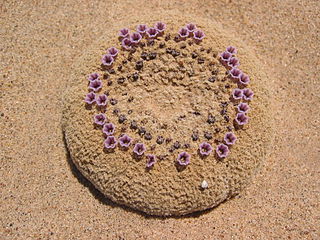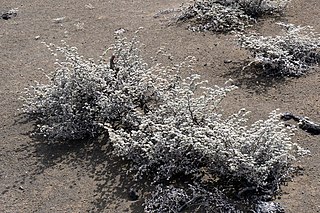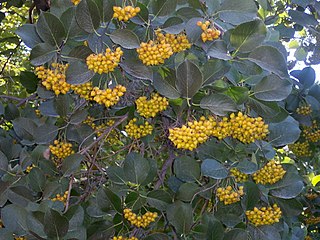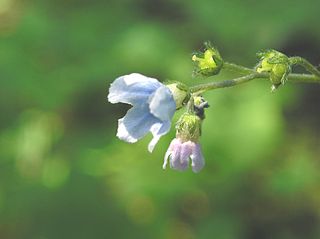
Boraginaceae, the borage or forget-me-notfamily, includes about 2,000 species of shrubs, trees, and herbs in 146 to 156 genera with a worldwide distribution.

Pholisma sonorae, commonly known as sandfood, is a rare and unusual species of flowering plant endemic to the Sonoran Deserts to the west of Yuma, Arizona in the California Yuha, Mojave Desert and Colorado Desert, and south in the Yuma Desert, where it is known from only a few locations.

Hackelia (stickseeds) is a genus of plants in the borage family, Boraginaceae. It includes 54 species found in North America, western South America, temperate Eurasia, and Australia. 12 species are native to California.

Tiquilia is a genus of flowering plants in the borage family, Boraginaceae. The 27 species in this genus are known by the common name crinklemat. They are native to the Western Hemisphere and are mostly found in desert regions.

Tiquilia nesiotica, known as gray matplant, is a species of plant in the family Boraginaceae. It is endemic to the Galápagos Islands.

Harpagonella is a genus of flowering plants in the borage family. They are known as the grappling-hooks, because of the appearance and function of their fruits. The strange fruits are two small nutlets enclosed in a burlike calyx, which is armed with numerous spines covered in minute, hooked barbs. These diminutive, annual plants are found in sandy, clayey, and gravelly soils, and have small white flowers. This genus is native to North America, and is found in southern California, southern Arizona, northern Sonora, and the Baja California peninsula.

Oreocarya virginensis is a species of wildflower in the family Boraginaceae known by the common name Virgin River cryptantha. This is a small plant native to the southwestern United States where it is a common plant in scrub and woodland. It is named for the Virgin River, a tributary of the Colorado River which runs through the region. This cryptantha is an annual or occasionally a perennial up to 40 centimeters in height. It is coated densely in long white hairs and bristles. The inflorescence is cylindrical or club-shaped, packed with tubular flowers with flat-faced corollas. The flower is usually bright white with yellow throat parts at the tube opening. The fruit is a rough, ridged nutlet.

Tiquilia canescens, the woody crinklemat or shrubby tiquilia, is a perennial, shrub in mid- to lower-elevation desert regions in the family Boraginaceae - Borage or the Forget-me-nots. It is found in the southwestern United States and Northwestern Mexico, in the states of California, Nevada, Arizona, Utah, New Mexico, Texas, Chihuahua, Sonora, and Baja California. It is a short, low-growing plant, seldom over 15 in tall.

Tiquilia nuttallii is an annual, subshrub-like plant of middle and higher elevation deserts in the family Boraginaceae - borages or the forget-me-nots. It is found in western North America from central Washington to western Colorado, and northern California and northern Arizona; it is also found in a disjunct population in Missouri.

Amsinckia menziesii is a species of plant in the family Boraginaceae, the borage or forget-me-not family.

Heliotropium curassavicum, commonly called salt heliotrope, a species of flowering plant in the borage family (Boraginaceae). It is native to much of the Americas, from Canada to Argentina, including the West Indies and Hawaii. It can be found as an introduced, and sometimes invasive, species in Africa, Asia, Australia, and Europe. It thrives in salty soils, such as beach sand, alkali flats, and salt marshes. It is often found in disturbed coastal sites.

Ehretioideae is a subfamily of the flowering plant family Boraginaceae.

Howellanthus is a monotypic genus of flowering plants in the borage family containing the single species Howellanthus dalesianus, commonly known as Scott Mountain phacelia or Howell's phacelia. Until 2010 the plant was known as Phacelia dalesiana. It is endemic to the southern Klamath Mountains of northern California, including the Scott Mountains for which it is named. It grows in mountain forests and meadows often on serpentine soils.

Phacelia neglecta is a species of flowering plant in the borage family, Boraginaceae. Its common names include alkali phacelia and neglected scorpionweed. It is native to the deserts of the southwestern United States in Nevada, Arizona, and southeastern California, where it grows in varied desert habitat, including areas with alkali soils. It is likely that its distribution extends into Baja California.

Potentilla flabellifolia is a species of cinquefoil known by the common names high mountain cinquefoil, fanleaf cinquefoil and fan-foil.
Tiquilia palmeri is a species of flowering plant in the borage family known by the common names Palmer's crinklemat and Palmer's tiquilia.
Lepismadora is a monotypic genus of beetles in the family Buprestidae, the jewel beetles. It contains the single species Lepismadora algodones, which is known by the common name Algodones sand jewel beetle. It is endemic to California in the United States, where it has been collected only from the Algodones Dunes in Imperial County.

Ellisia is a genus of flowering plants in the forget-me-not family (Boraginaceae), containing the sole species Ellisia nyctelea. It is native to North America, where it is also known as Aunt Lucy, false baby blue eyes, and waterpod. The genus was named in honor of British naturalist John Ellis, a contemporary of, and correspondent to, Carl Linnaeus. It was published and described by Linnaeus, in his book Species Plantarum ed.2 on page 1662 in 1763.

Andersonglossum is a small genus of North American plants in the borage family (Boraginaceae). They are commonly called American comfreys, wild comfreys, or hound's tongues.


















